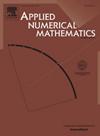Variable-time-step weighted IMEX FEMs for nonlinear evolution equations
IF 2.2
2区 数学
Q1 MATHEMATICS, APPLIED
引用次数: 0
Abstract
In this paper, the variable-time-step weighted implicit-explicit (IMEX) finite element methods (FEMs) are developed for some types of nonlinear real- or complex-valued evolution equations. Extensive research is conducted on the discrete orthogonal convolution (DOC) kernels and the discrete complementary convolution (DCC) kernels of the variable-time-step weighted IMEX scheme, elucidating their crucial properties in both real- and complex-valued scenarios. We prove that the scheme exhibits optimal convergence without any restrictions on the time-space step ratio. At last, several numerical examples are provided to demonstrate our theoretical results. With the weighted parameter , the scheme in this work can degenerate into a special case: variable-time-step two-step backward differentiation formula (BDF2) scheme, and the convergence analysis in this special case was introduced in Liao et al. (2020) [15] and Liao et al. (2021) [29].
求助全文
约1分钟内获得全文
求助全文
来源期刊

Applied Numerical Mathematics
数学-应用数学
CiteScore
5.60
自引率
7.10%
发文量
225
审稿时长
7.2 months
期刊介绍:
The purpose of the journal is to provide a forum for the publication of high quality research and tutorial papers in computational mathematics. In addition to the traditional issues and problems in numerical analysis, the journal also publishes papers describing relevant applications in such fields as physics, fluid dynamics, engineering and other branches of applied science with a computational mathematics component. The journal strives to be flexible in the type of papers it publishes and their format. Equally desirable are:
(i) Full papers, which should be complete and relatively self-contained original contributions with an introduction that can be understood by the broad computational mathematics community. Both rigorous and heuristic styles are acceptable. Of particular interest are papers about new areas of research, in which other than strictly mathematical arguments may be important in establishing a basis for further developments.
(ii) Tutorial review papers, covering some of the important issues in Numerical Mathematics, Scientific Computing and their Applications. The journal will occasionally publish contributions which are larger than the usual format for regular papers.
(iii) Short notes, which present specific new results and techniques in a brief communication.
 求助内容:
求助内容: 应助结果提醒方式:
应助结果提醒方式:


